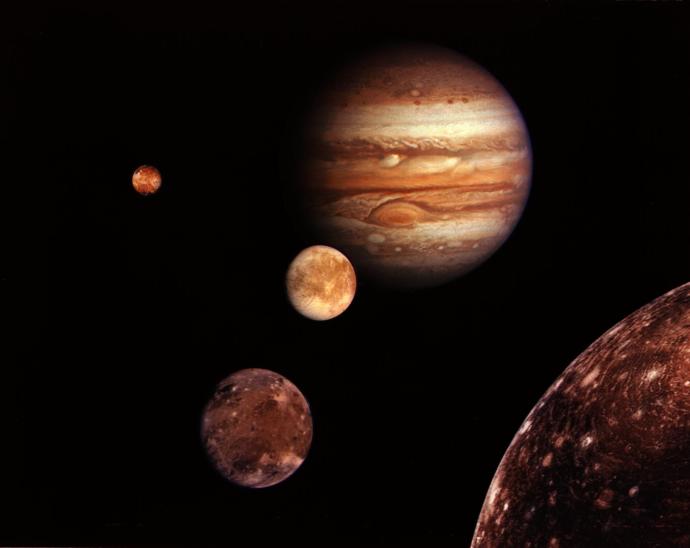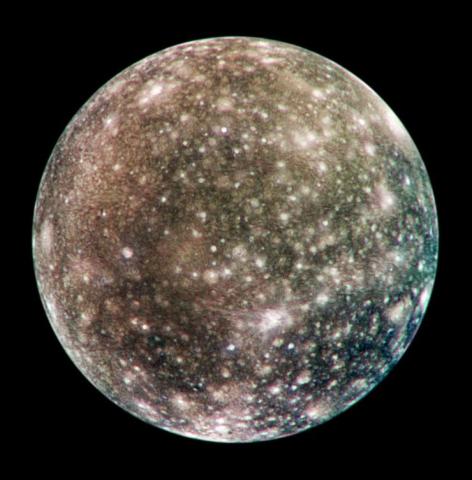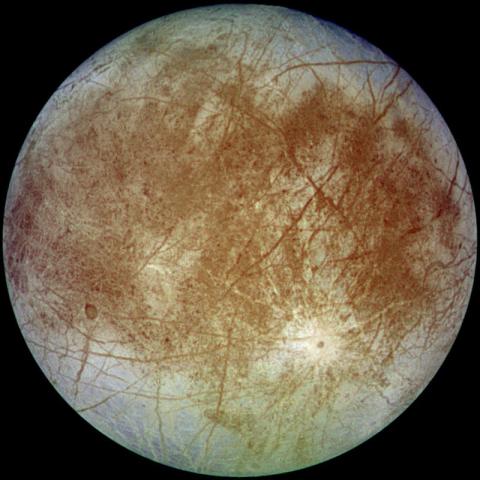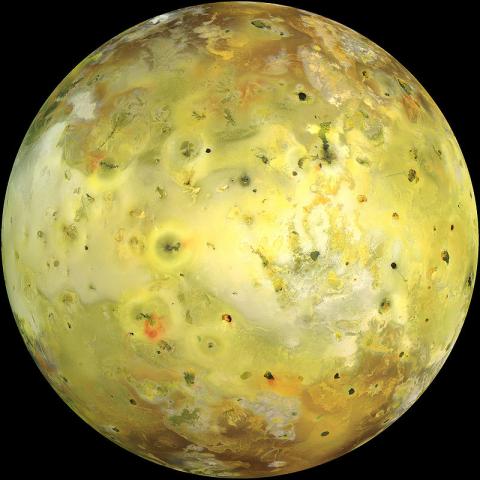Jupiter is the fifth planet from the Sun and the largest planet in the Solar System.
It is more than twice as massive as all the other planets in our Solar System put together. It is so big that all the other planets would fit inside it!
As huge as Jupiter is, it is only a thousandth the mass of the Sun. And 11,000 planet Jupiter's could fit inside our star!
Jupiter is a gas giant planet. This means that is does not have a solid surface. It is mostly made of gas and is thought to have a small solid core.
Jupiter is made up of mainly hydrogen (75%) and helium (24%). The light coloured bands of cloud are made of ammonia ice and are called zones. The darker coloured bands, or belts, are thought to be made up of sulphur, and phosphorus.
Jupiter spins faster than any other planet in the Solar System. One day on Jupiter is around 10 hours long! Even though it's day is much shorter than the Earth's its year is longer. This is because Jupiter is much further from the Sun. It takes 12 Earth years for Jupiter to go around the Sun once.
One of the most famous features of Jupiter is the Great Red Spot. This is a giant storm, which has been raging for at least 150 years. The storm is twice the size of the Earth.
Jupiter has dozens of moons. The largest four were discovered in 1610 by Galileo. They are called: Io, Europa, Ganymede and Callisto. We don't think that life could survive on Jupiter. But when scientists look for places life could live in the Solar System they often look at Europa. The oceans on Europa, under the icy crust, might be one of the best places for life to evolve.
The first spacecraft visited Jupiter in 1973. Many others have looked at Jupiter since whilst exploring the Solar System. The mission Galileo spent years studying the planet between 1995 and 2003. In 2016, the NASA mission, Juno, arrived at Jupiter hoping to get clues about how the planet formed, but we still have many questions.

- Moons
The gas giant planet, Jupiter has more than 90 moons. So far, fewer than 60 of the moons have been named, the rest are waiting for official names.
Io, Europa, Ganymede, and Callisto are known as the Galilean moons in honour of the the astronomer who discovered them, Galileo Galilei. Galileo first observed these large moons in 1610. Most of Jupiter's smaller moons are recent discoveries - more than 70 of them have been found since 1999. Astronomers may find more moons around Jupiter in the future.
Io, Ganymede and Callisto are the largest of Jupiter's moons. These 4 moons are each bigger than the Earth's moon. They are so big, you can see them with a good pair of binoculars! They will only look like small spots of light, a bit like a star. But you know they are moons because they appear in a straight line that crosses Jupiter.
The other moons of Jupiter are much, much smaller than the Galilean moons. If you added the total mass of those dozens of small moons to make 1 moon, it would still be thousands of times smaller than Europa, the smallest Galilean moon.
Many spacecraft have visited Jupiter and its moons. The Pioneer missions took photos of the Galilean moons in 1973 and 1974. The Voyager spacecraft discovered volcanoes on Io and water ice on Europa in 1979. The Galileo spacecraft orbited Jupiter from 1995 to 2003 and discovered Ganymede's magnetic field.
Facts and Figures Io Europa Ganymede Callisto a 1 Earth Mass = 5,980,000,000,000,000,000,000,000 kg Distance from Jupiter (km) 421,600 670,900 1,070,000 1,883,000 Radius (km) 1,815 1,569 2,631 2,400 Mass (Earth Masses) a 0.015 0.008 0.025 0.018 Time of Orbit (Earth Days) 1.77 3.55 7.15 16.69 Day Length (Earth Days) 1.77 3.55 7.15 16.69 Image CreditThis work by NASA/JPL is licensed under Creative Commons Zero v1.0 Universal
CreditThis work by NASA/JPL is licensed under Creative Commons Zero v1.0 UniversalA montage of Jupiter's Moons - Callisto
Callisto is the 2nd largest of Jupiter's moons. It is the 3rd largest moon in the whole Solar System. Like the other Galilean moons, Callisto was first seen by Galileo Galilei in 1610.
Just like Earth's Moon, Callisto is tidally locked to its planet. This means it makes an orbit of Jupiter in the same time it takes to rotate once on its axis. As a result, it always shows the same side to Jupiter.
Callisto is so big it is about the same size as the planet Mercury! However, it only contains about a third of the mass of Mercury, making it much less dense. The average density of Callisto is only twice that of water.
Scientists think Callisto is made of rock and ice. It may even have an ocean under its surface. The surface of the moon is surrounded by a very thin atmosphere. This atmosphere is made of carbon dioxide and may contain small traces of oxygen.
Callisto's rocky surface is covered in lots of craters. These craters were made by many asteroid impacts over a long period of time. Callisto does not show any signs of recent volcanoes or plate tectonics. This means the craters on its surface have remained there for millions of years. Scientists think the surface of Callisto is older than those of other moons and planets in the Solar System.
Image CreditThis work by NASA is licensed under Creative Commons Zero v1.0 Universal
CreditThis work by NASA is licensed under Creative Commons Zero v1.0 UniversalCallisto - Europa
Europa is one of Jupiter's large moons. Like the other Galilean moons, Europa was first seen by Galileo Galilei in 1610. Europa is the only Galilean moon which is smaller than Earth's own Moon.
Europa's surface is made of water ice. Scientists think a huge ocean may be hidden under its icy surface. This means Europa could contain twice as much water as all the Earth's oceans put together! Europa also has a very thin atmosphere made mainly of oxygen.
The surface of Europa is unusual because it does not have many impact craters. This leads scientists to think any old asteroid impacts have been erased and the surface is fairly new. The surface is covered with a thick layer of ice, with lots of cracks in it. These cracks show up as dark lines streaking across the moon's surface in a crisscross pattern. It is thought these sorts of cracks form when surfaces melt, drift apart a little and then re-freeze.
In 2013, the Hubble Space Telescope made observations which suggested Europa was sending plumes of water into space. These plumes must be made by some kind of geology within the moon which suggests a source of heat. The presence of water, oxygen and heat makes Europa a good place to search for life!
Image CreditThis work by NASA is licensed under Creative Commons Zero v1.0 Universal
CreditThis work by NASA is licensed under Creative Commons Zero v1.0 UniversalEuropa - Ganymede
Ganymede is the largest of Jupiter's moons and the largest in the whole Solar System. It is even bigger than the planet Mercury, but only about half the mass. This means it must be much less dense. It is twice the mass of Earth's Moon.
It only takes 7 days for Ganymede to orbit Jupiter. The moon is so large it has its own magnetic field - but has no atmosphere around it.
The surface is made up of a mixture of rock and water ice. The Galileo spacecraft found evidence of a saltwater ocean nearly 200 km below its surface. The ocean is sandwiched between layers of ice. It is thought that there is more water in this ocean, than in all the oceans on Earth. There is a small chance that simple forms of life may exist in that ocean.
The surface appears complicated with mountains, valleys, flat plains and craters. It also has many light and dark regions. The darker regions have more craters and are thought to be older. The light regions likely to be caused by recent plate movement.
Image CreditThis work by NASA is licensed under Creative Commons Zero v1.0 Universal
CreditThis work by NASA is licensed under Creative Commons Zero v1.0 UniversalGanymede - Io
Io is one of Jupiter's large moons. Io is the closest large moon to Jupiter. It is a bit larger than the Earth's Moon.
Just like Earth's Moon, Io is tidally locked to its planet. This means it makes an orbit of Jupiter in the same time it takes to rotate once. This means that it always shows the same side to Jupiter.
The orbit of Io is very elliptical. Sometimes the moon is very close to Jupiter and sometimes it much further away. This large change in distance has an effect on the moon. When it is close to Jupiter it feels a much stronger gravitational pull from the planet. The changes in gravity pull at the moons surface. It is thought that this is why the moon is so active.
Io is the most active object in the Solar System. Its surface is covered with hundreds of volcanoes. There are huge numbers of lava flows across the surface. When the Galileo spacecraft passed the moon it was able to take images of this activity.
Io's surface is also dotted with more than 100 mountains. Some of these them are taller than Earth's Mount Everest.
The volcanoes on Io pump out sulphur. The plumes can reach a height of up to 500 km (310 miles) above the moon's surface. All the gas released from the volcanoes has created a thin atmosphere around Io. But it would be far too poisonous for people to breathe. It is very unlikely that life exists on Io.
Image CreditThis work by NASA is licensed under Creative Commons Zero v1.0 Universal
CreditThis work by NASA is licensed under Creative Commons Zero v1.0 UniversalIo
